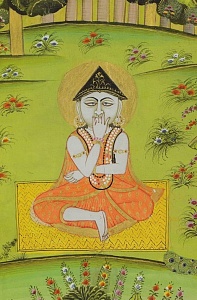News
-
 Pranayama workshop, Mar 1-7
Pranayama workshop, Mar 1-7
-
 21-day Pranayama challenge
21-day Pranayama challenge
-
 Nāda meditation workshop, January 8-12
Nāda meditation workshop, January 8-12
-
 April 3, Navaratri with Yogi Matsyendranath Maharaj, Australia, Queensland
April 3, Navaratri with Yogi Matsyendranath Maharaj, Australia, Queensland
-
 March 17, 2020. Purifiying Pranayama With Yogi Matsyendra Nath
March 17, 2020. Purifiying Pranayama With Yogi Matsyendra Nath
-
 November 2019, Tantra Workshop Series in Argentina
November 2019, Tantra Workshop Series in Argentina
-
 Workshop in Gualeguaychu
Workshop in Gualeguaychu
-
 17-18 November 2018, Yogi Matsyendranath in Źarate (Argentina)
17-18 November 2018, Yogi Matsyendranath in Źarate (Argentina)
-
 15-16 November 2018, Yogi Matsyendranath visit to Uruguay
15-16 November 2018, Yogi Matsyendranath visit to Uruguay
-
 12 Nov 2018, Lecture at USAL (Salvador University)
12 Nov 2018, Lecture at USAL (Salvador University)
-
 10-11 November 2018, Workshops in Quilmes and La Plata (Argentina)
10-11 November 2018, Workshops in Quilmes and La Plata (Argentina)
-
 8 November 2018, Open conference in Necochea (Argentina)
8 November 2018, Open conference in Necochea (Argentina)
-
 2,3,4 November 2018 - Participating in XVI Retreat International of Yoga and Meditation
2,3,4 November 2018 - Participating in XVI Retreat International of Yoga and Meditation
-
 Programme in Québec (Canada) 13-16 June
Programme in Québec (Canada) 13-16 June
-
 Melbourne Book Launch
Melbourne Book Launch
-
 4-years Summer Program
4-years Summer Program
-
 Biography of a Russian Yogi
Biography of a Russian Yogi
-
 November 2017, Visit of Yogi Matsyendranath to Argentina
November 2017, Visit of Yogi Matsyendranath to Argentina
-
 Satsangs of Yogi Matsyendranatha Maharaj in Berlin
Satsangs of Yogi Matsyendranatha Maharaj in Berlin
-
 Seminars and trainings in June-July 2015 (France)
Seminars and trainings in June-July 2015 (France)
Tag cloud
Authorization
Prana and pranayama

Prana is usually associated with consciousness, and with his work. Also prana is associated with breathing, but prana means "vital energy", and it especially manifests itself in breathing, because breathing is important function in our organism. But all other processes in the body such as metabolism, digestion, temperature, operation of the nervous system, reproductive, circulatory, muscular and other depend on prana. If you slow down some functions, the prana spent on their activity is preserved and resource of prana becomes bigger. For example, during a fast, during sexual abstinence, when you are silent for a long time (the talk takes energy), when you hold your breath, you save prana.
As you can see, the control of prana may not necessarily is connected with breathing, but control through the breath is one of the most effective methods. Yogis invented many ways: for example, vairagya (desistance, braking desires, passions, lust) is also sometimes affects no less than pranayama as we usually understand it, as the form of breath control. Uncontrolled passions also consume prana and if you slow down them, you increase the level of prana, it turns prana (life force) ayama (increase).
Pranayama means “prana” (life force) and ayama (extension, stretching, increasing). It is the practice, that expands the standard features of the vital energy and consciousness (because it depends on prana). Fluctuations in consciousness (vritti) and vibrations of prana (prana-nirodha) should disappear. The higher realization of pranayama you achieved, the more peaceful mind you have, including emotions, which depend on mind.
Translation of names of the simple pranayama elements is very important. Kumbhaka means something like a pitcher, Puraka means filling, fulness, Rechaka is expulsion, ousting, extraction. Also, the body itself is called a pitcher. Birth begins with the inhalation, and death – with the exhalation. What is the filling? It happens when all parts of the body are evenly filled with prana. It is possible only when the body is free from the muscle tension. The practice of asanas in this case is an exception because it contains other processes. Exhale is a return to the state which was before filling. Rough, sharp exhalation is like a sudden death or momentary falling asleep. There are the points of maximum emptying – “shunya” and maximum fullness –“purnam” between inhalation and exhalation.
During inhalation and exhalation you import condition of these two points in the process of inhalation and exhalation. In the Nath tradition main puja is done after sleep and before bedtime, because the state of the puja applies to all day and night. Our subtle body also has its own "days and nights", they are also associated with the inhalation and exhalation. The aim of pranayama is to lead to a gradual integration of the diversity of prana, which is caused by the inhalation and exhalation. It happens through the making breath more subtle, and as a result your mind becomes clear.
Breathing is a continuous cycle, that’s why it’s called "ajapa-japa". All things continuously circle, the processes of creation and destruction are also ajapa-japa, therefore this is the practice of staying in harmony. Exhale and inhale are the circle or cycle, they become smoother if you practice regular, smoothness is also associated with the level of cleanliness of the nadis. If breathing and the flow of vibration easily spread in our energy system, that's means that we have a lot of life force, and we see more and more opportunities, interconnections outside. It happens against the background of the deep relaxation and inner silence.
Tags: yoga pranayama sadhana
Author: Yogi Matsyendranath Maharaj

